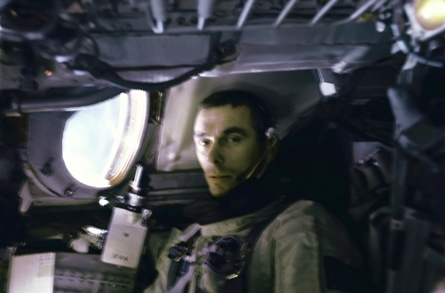Eugene “Gene” Cernan is adamant that a manned Moon mission without a rover for transporting astronauts and equipment across the lunar surface is a "stupid idea".
|
|---|
Above: Eugene "Gene" Cernan's official Apollo 10 portrait |
“To take the equipment and material needed its [the rover] an absolute requirement, going back without it is foolish,” says Cernan, speaking to Flight at the opening of the NASA, American Institute of Aeronautics and Astronautics second space exploration conference held in Houston, Texas from 4-6 December, “we cannot be truly effective on the Moon without some transport. We fully explored a valley 20 miles long (37km) and five miles wide, only because we had the lunar rover.”
Apollo 17 commander, Apollo 10 lunar excursion module (LEM) Snoopy pilot, Gemini IX mission pilot, with a total of 566h and 15min in space Cernan’s experience is invaluable to NASA’s plans for a return to the Moon by 2020. And for that reason he and his fellow Apollo programme astronauts are contributing to the US space agency’s Constellation programme and its plans for Moon missions.
|
|---|
Above: Cernan is photographed inside the Gemini spacecraft |
Constellation’s engineers might want to ask for his help on designs anyway. He was the LEM pilot for Apollo 10’s lunar lander verification flight test and he and his mission commander, and Gemini IX commander, Thomas Stafford descended to an altitude of less than 48,600ft (14,800m) above the Moon’s surface in May of 1969.
Cernan certainly wants the US space programme’s current crop of managers and engineers to take advantage of his generation’s experience. “It behoves the contractors and NASA to take advantage of what we, the [Apollo] astronauts, flight controllers, engineers, have to offer.”
During their lunar descent Stafford and Cernan employed almost all of the procedures for an actual lunar landing. That flight test enabled critical evaluations of the LEM propulsions systems, landing radar and other devices for the subsequent command module, LEM lunar orbit rendezvous and re-docking manoeuvres.
“We did a lot of debriefing then [for Apollo] but there were so many things that we did not put down in writing. [By discussing those missions today] we can come up with some pretty valuable information that is probably not documented. It is important to get those inputs in at the design stage [of Constellation’s transportation systems].”
|
|---|
Above: Cernan operates an aerospace flight simulator in Dallas, Texas |
Cernan is humble about the extent that he and his fellow Apollo veterans can help and admits that the space programme made mistakes in the 1960s and wants NASA to avoid the same errors. Errors that led to the deaths of astronauts Virgil “Gus” Grissom, Roger Chaffee and Edward White in an on-pad fire in the command module in January 1967. During Cernan’s speech opening the NASA, AIAA conference he recalled the astronauts' feelings afterward. “We didn’t know if we were laying to rest three friends, colleagues, or if we were burying the Apollo programme.”
Reflecting upon the later achievements of Apollo Cernan thinks NASA should be aiming higher, and he isn’t disappointed by the lunar architecture unveiled this week at the Houston space conference. That describes six month missions for four or more astronauts at a solar-powered polar lunar outpost.
“We need to take Apollo 17 as a yard stick, to build upon that. We should build on what we learned [and] that’s exactly what’s happening.” NASA’s plans include a pressurised rover. Early designs by the likes of its, California Institute of Technology managed Jet Propulsion Laboratory, show an astronaut carrying cylindrical pressure vessel atop a mobile base with wheels whose legs can articulate in many axes to cope with the undulating lunar terrain.
Nothing like the unpressurised electric car he and his LEM pilot Harrison “Jack” Schmitt sped round the Moon on.
“[Driving the rover] every time you hit a crater or boulder you were on three wheels. But it was not a hindrance and you got used to it.” Cernan smiled as he remembered the three-day expedition he enjoyed amongst the billion year old boulders of Taurus-Littrow, located on the southeast edge of the Moon's Mare Serenitatis.
|
|---|
Above: Commander Cernan drives the Apollo 17 lunar rover |
|
|---|
Above (L-R): The first and last Moon landing Apollo commanders Neil Armstrong and Gene Cernan |
Source: FlightGlobal.com
























